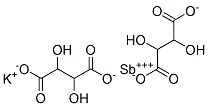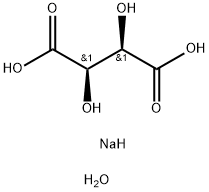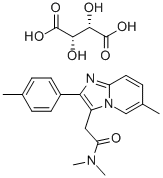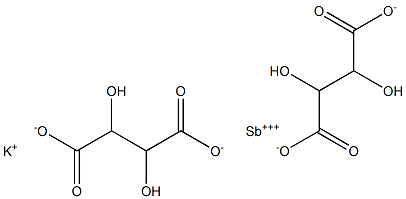Potassium antimonyl tartrate sesquihydrate
Synonym(s):Antimony potassium tartrate trihydrate;Antimony potassium tartrate, Potassium antimony tartrate, Tartar emetic;Potassium antimony(III) oxide tartrate trihydrate;Tartar emetic
- CAS NO.:28300-74-5
- Empirical Formula: C8H4O12Sb2.3H2O.2K
- Molecular Weight: 667.87
- MDL number: MFCD00167056
- EINECS: 608-190-2
- SAFETY DATA SHEET (SDS)
- Update Date: 2024-03-14 15:18:25

What is Potassium antimonyl tartrate sesquihydrate?
Description
Antimony potassium tartrate is an odorless,colorless, crystalline material, or white powder with asweetish, metallic taste. Molecular weight= 635.88;Specific gravity (H2O:1)= 2.6. Hazard Identification(based on NFPA-704 M Rating System): Health 2,Flammability 0, Reactivity 0. Soluble in water; solution isslightly acidic.
Chemical properties
colourless crystals
Chemical properties
Antimony potassium tartrate is an odorless, colorless, crystalline material or white powder with a sweetish, metallic taste.
The Uses of Potassium antimonyl tartrate sesquihydrate
As mordant in the textile and leather industry.
The Uses of Potassium antimonyl tartrate sesquihydrate
Potassium antimonyl tartrate trihydrate is used in chemical therapy treatment of Leishmania guyanensis and Leishmania braziliensis however may be susceptible to antimony resistance.
The Uses of Potassium antimonyl tartrate sesquihydrate
Potassium antimonyl tartrate trihydrate was employed as an Sb(III)-containing drug to investigate its ability to induce cell death associated with DNA fragmentation in axenic amastigotes of Leishmania infantum?
It may also be used as a standard solution to determine the metalloid concentration such as Sb(III) and Sb(V) in surface soil, using high performance liquid chromatography coupled to inductively coupled plasma-mass spectrometry (HPLC-ICP-MS).
General Description
Potassium antimonyl tartrate sesquihydrate solid is a colorless crystalline solid or a white powder. Potassium antimonyl tartrate sesquihydrate is soluble in water. Potassium antimonyl tartrate sesquihydrate is used in textile and leather processing and as an insecticide.
Air & Water Reactions
Potassium antimonyl tartrate sesquihydrate effloresces on exposure to air. Water soluble.
Reactivity Profile
Potassium antimonyl tartrate sesquihydrate reacts with tannic acid, alkalis and their carbonates, lead salts, astringent infusions (cinchona, rhubarb, etc.), acacia, antipyrene and mercury bichloride. Potassium antimonyl tartrate sesquihydrate also reacts with acids, salts of heavy metals, albumins, soap and tannins. Potassium antimonyl tartrate sesquihydrate can react with strong oxidizing agents. .
Health Hazard
Inhalation causes inflammation of membranes of nose and throat, upper respiratory irritation, headache, dizziness. Ingestion causes gastrointestinal upset, strong irritation, vomiting. Contact with eyes or skin causes irritation. Further symptoms of exposure include nervous complaints (i.e., irritability, dizziness, muscular and neurological pain).
Fire Hazard
Non-combustible, substance itself does not burn but may decompose upon heating to produce corrosive and/or toxic fumes. Containers may explode when heated. Runoff may pollute waterways.
Safety Profile
Human poison by intravenous route, producing liver and kidney changes, somnolence, dyspnea, and pupillary dilation. Poison by ingestion, subcutaneous, intravenous, intramuscular, and intraperitoneal routes. Large doses cause severe liver damage. Human mutation data reported. Used medicinally, the therapeutic dose is close to the toxic dose. Upon decomposition it emits toxic fumes of K2O and Sb.
Potential Exposure
It is used in medicine; textile and leather dyeing; as an insecticide.
First aid
If this chemical gets into the eyes, remove anycontact lenses at once and irrigate immediately for at least15 min, occasionally lifting upper and lower lids. Seek medical attention immediately. If this chemical contacts theskin, remove contaminated clothing and wash immediatelywith soap and water. Seek medical attention immediately. Ifthis chemical has been inhaled, remove from exposure,begin rescue breathing (using universal precautions, including resuscitation mask) if breathing has stopped and CPR ifheart action has stopped. Transfer promptly to a medicalfacility. When this chemical has been swallowed, getmedical attention. Give large quantities of water and inducevomiting. Do not make an unconscious person vomit.Medical observation is recommended for 24°48 h afterbreathing overexposure, as pulmonary edema may bedelayed. As first aid for pulmonary edema, a doctor orauthorized paramedic may consider administering a corticosteroid spray.
storage
Color Code—Blue: Health Hazard/Poison: Store ina secure poison location. Prior to working with this chemicalyou should be trained on its proper handling and storage.Store in tightly closed containers in a cool, well-ventilatedarea away from heat.
Shipping
UN1549 Antimony potassium tartrate, Hazard Class: 6.1; Labels: 6.1-Poisonous materials.
Purification Methods
Crystallise it from water (3mL/g) between 100o and 0o. Dry it at 100o. [Chinoporos & Papathanosopolos J Phys Chem 65 1643 1961, Beilstein 3 III 1014, 3 IV 1227.]
Incompatibilities
Solution will react with alkaline materials.
Waste Disposal
Consult with environmental regulatory agencies for guidance on acceptable disposal practices. Generators of waste containing this contaminant (≥100 kg/mo) must conform with EPA regulations governing storage, transportation, treatment, and waste disposal.
Properties of Potassium antimonyl tartrate sesquihydrate
| Melting point: | ≥300 °C(lit.) |
| alpha | D20 +140.69° (c = 2 in water), +139.25° (c = 2 in glycerol) |
| Density | 2,607 g/cm3 |
| storage temp. | Store at +15°C to +25°C. |
| solubility | water: soluble |
| form | Powder |
| color | White |
| Specific Gravity | 2.6 |
| PH | 4.0 (50g/l, H2O, 20℃) |
| Water Solubility | 8.3 g/100 mL |
| Merck | 14,700 |
| Exposure limits | ACGIH: TWA 0.5 mg/m3 NIOSH: IDLH 50 mg/m3; TWA 0.5 mg/m3 |
| Stability: | Stable. Incompatible with alkalies, carbonates, strong oxidizing agents. |
| CAS DataBase Reference | 28300-74-5(CAS DataBase Reference) |
| EPA Substance Registry System | Antimony potassium tartrate (28300-74-5) |
Safety information for Potassium antimonyl tartrate sesquihydrate
| Signal word | Danger |
| Pictogram(s) |
 Skull and Crossbones Acute Toxicity GHS06  Environment GHS09 |
| GHS Hazard Statements |
H301:Acute toxicity,oral H315:Skin corrosion/irritation H317:Sensitisation, Skin H332:Acute toxicity,inhalation H411:Hazardous to the aquatic environment, long-term hazard |
| Precautionary Statement Codes |
P261:Avoid breathing dust/fume/gas/mist/vapours/spray. P273:Avoid release to the environment. P280:Wear protective gloves/protective clothing/eye protection/face protection. P301+P310:IF SWALLOWED: Immediately call a POISON CENTER or doctor/physician. P302+P352:IF ON SKIN: wash with plenty of soap and water. |
Computed Descriptors for Potassium antimonyl tartrate sesquihydrate
| InChIKey | BBUFTTIHMIIQLI-UHFFFAOYSA-J |
Abamectin manufacturer
JSK Chemicals
Pallav Chemicals And Solvents Pvt Ltd
ARRAKIS INDUSTRIES LLP
New Products
4-Aminotetrahydropyran-4-carbonitrile Hydrochloride (R)-3-Aminobutanenitrile Hydrochloride 4-AMINO-TETRAHYDRO-PYRAN-4-CARBOXYLIC ACID HCL 4-(Dimethylamino)tetrahydro-2H-pyran-4-carbonitrile 3-((Dimethylamino)methyl)-5-methylhexan-2-one oxalate 1,4-Dioxa-8-azaspiro[4.5]decane 5-Bromo-2-nitropyridine Nimesulide BP Aceclofenac IP/BP/EP Diclofenac Sodium IP/BP/EP/USP Mefenamic Acid IP/BP/EP/USP Ornidazole IP Diclofenac Potassium SODIUM AAS SOLUTION ZINC AAS SOLUTION BUFFER SOLUTION PH 10.0(BORATE) GOOCH CRUCIBLE SINTERED AQUANIL 5 BERYLLIUM AAS SOLUTION 2-Bromo-1-(bromomethyl)-3-chloro-5-nitrobenzene 2-Bromo-3-nitroaniline N-(3-Hydroxypropyl)-N-methylacetamide 3-Bromo-6-chloropyridazine 4-ethyl-3-nitrobenzoic acidRelated products of tetrahydrofuran








You may like
-
 Antimony potassium tartrate trihydrate CAS 28300-74-5View Details
Antimony potassium tartrate trihydrate CAS 28300-74-5View Details
28300-74-5 -
 Antimony potassium tartrate trihydrate CAS 28300-74-5View Details
Antimony potassium tartrate trihydrate CAS 28300-74-5View Details
28300-74-5 -
 Antimony potassium tartrate trihydrate CAS 28300-74-5View Details
Antimony potassium tartrate trihydrate CAS 28300-74-5View Details
28300-74-5 -
 Antimony Potassium Tartrate Hemihydrate extrapure AR CAS 28300-74-5View Details
Antimony Potassium Tartrate Hemihydrate extrapure AR CAS 28300-74-5View Details
28300-74-5 -
 Antimony potassium tartrate trihydrate CAS 28300-74-5View Details
Antimony potassium tartrate trihydrate CAS 28300-74-5View Details
28300-74-5 -
 Antimony potassium tartrate, 99% CAS 28300-74-5View Details
Antimony potassium tartrate, 99% CAS 28300-74-5View Details
28300-74-5 -
 Antimony Potassium Tartrate Hemihydrate pure CAS 28300-74-5View Details
Antimony Potassium Tartrate Hemihydrate pure CAS 28300-74-5View Details
28300-74-5 -
 Antimony potassium tartrate, GR 99%+ CAS 28300-74-5View Details
Antimony potassium tartrate, GR 99%+ CAS 28300-74-5View Details
28300-74-5